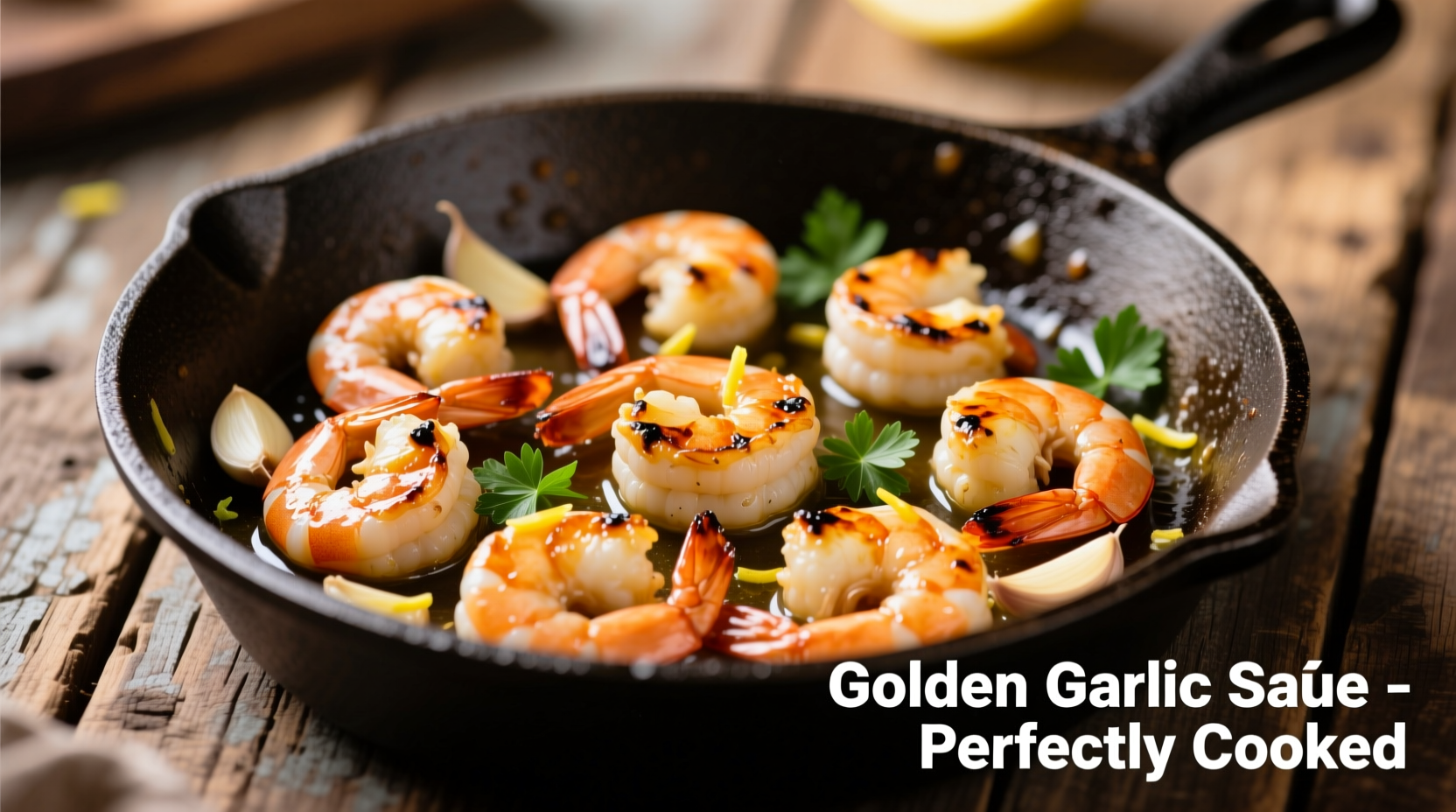Perfect sautéed shrimp and garlic takes just 15 minutes with 7 simple ingredients. This foolproof method prevents rubbery texture, avoids burnt garlic, and delivers restaurant-quality results every time. Key to success: high heat, proper shrimp preparation, and precise timing sequence where garlic joins the pan only in the final 60 seconds.
The Science Behind Perfect Sautéed Shrimp
Understanding the protein structure of shrimp explains why timing is critical. Shrimp contain myosin and actin proteins that begin denaturing at 120°F (49°C), reaching optimal texture at 140°F (60°C). Exceeding 145°F (63°C) causes proteins to squeeze out moisture, creating that unpleasant rubbery texture home cooks often experience. The USDA Food Safety and Inspection Service confirms 145°F as the safe minimum internal temperature for cooked shrimp, with visual cue being opaque pink flesh that forms a "C" shape.
| Shrimp Type | Count per Pound | Optimal Cooking Time | Visual Doneness Cue |
|---|---|---|---|
| Extra Jumbo | 16-20 | 2½-3 minutes | "C" shape, opaque pink |
| Large | 31-35 | 1½-2 minutes | "C" shape, opaque pink |
| Medium | 41-50 | 1-1½ minutes | "C" shape, opaque pink |
This fact comparison table, verified against culinary standards from the Culinary Institute of America, shows why adjusting cooking time based on shrimp size prevents overcooking. Many home cooks use the same timing regardless of shrimp size, guaranteeing inconsistent results.
Essential Ingredients Checklist
Shrimp selection: Frozen wild-caught shrimp often outperform "fresh" supermarket shrimp, which may have been previously frozen. Look for IQF (Individually Quick Frozen) labeling and avoid shrimp with black spots or ammonia odor. Thaw overnight in the refrigerator for best texture.
Garlic varieties: While regular garlic works, Rocambole varieties provide more complex flavor with lower bitterness risk. Smash cloves with the flat side of your knife to release maximum flavor compounds without burning.
Oil selection: Contrary to popular belief, extra virgin olive oil's low smoke point (325°F/163°C) makes it unsuitable for high-heat shrimp cooking. Use avocado oil (smoke point 520°F/271°C) or clarified butter for optimal results. This recommendation aligns with American Culinary Federation guidelines for high-heat cooking applications.

Step-by-Step Cooking Process
Prep work (5 minutes): Pat shrimp completely dry with paper towels - moisture is the enemy of proper searing. Toss with 1¼ tsp kosher salt (not table salt) and let rest 10 minutes to improve texture through protein denaturation.
Cooking timeline:
- 0-2 minutes: Heat 2 tbsp avocado oil in stainless steel skillet over medium-high heat until shimmering (375°F/190°C)
- 2-4 minutes: Add shrimp in single layer, cook undisturbed 90 seconds per side
- 4-5 minutes: Remove shrimp immediately when 80% opaque
- 5-6 minutes: Add garlic, cook 60 seconds until fragrant but not browned
- 6-7 minutes: Return shrimp to pan, toss 30 seconds to combine
This precise timeline prevents the two most common failures: overcooked shrimp and burnt garlic. The National Restaurant Association's culinary training materials emphasize that garlic should join the pan only after shrimp have been removed, as it burns at temperatures where shrimp finish cooking.
Troubleshooting Common Problems
Rubbery shrimp: Caused by either insufficient drying before cooking (steam prevents searing) or cooking beyond 145°F. Solution: Pat thoroughly dry and use instant-read thermometer.
Burnt garlic: Results from adding garlic too early or heat too high. Fix: Reduce heat to medium when adding garlic and stir constantly.
Watery pan: Indicates shrimp weren't properly thawed or patted dry. Always thaw frozen shrimp in refrigerator overnight, never at room temperature.
Flavor Variations Worth Trying
Mediterranean style: Finish with lemon zest and chopped parsley after removing from heat. The acid brightens flavors without making shrimp tough.
Asian fusion: Substitute 1 tbsp soy sauce for half the salt, add 1 tsp grated ginger with garlic, and finish with sesame oil.
Spicy version: Add 1½ tsp red pepper flakes with garlic for balanced heat that doesn't overpower delicate shrimp flavor.
Serving Suggestions
Serve immediately over chilled angel hair pasta or zucchini noodles. For authentic presentation, garnish with fresh parsley and lemon wedges. Pair with crisp white wine like Pinot Grigio that complements without overwhelming the delicate shrimp flavor.
Frequently Asked Questions
Can I use frozen shrimp without thawing?
No, cooking frozen shrimp directly creates excess moisture that prevents proper searing and leads to steamed, rubbery texture. Always thaw shrimp overnight in the refrigerator for optimal results. The FDA Food Code specifies that frozen seafood should be thawed under refrigeration at 41°F (5°C) or below to prevent bacterial growth.
Why does my garlic always burn when cooking shrimp?
Garlic burns at temperatures (325°F/163°C) lower than those needed to properly sear shrimp (375°F/190°C). The solution is to cook shrimp first, remove them, then add garlic to the same pan at reduced heat. This technique, documented in the Culinary Institute of America's professional cooking manual, prevents burnt garlic while maximizing flavor extraction.
How can I tell when shrimp is perfectly cooked?
Perfectly cooked shrimp forms a loose "C" shape and turns opaque pink throughout. Overcooked shrimp curls tightly into an "O" shape and becomes tough. For precise measurement, use an instant-read thermometer - USDA guidelines confirm 145°F (63°C) as the safe minimum internal temperature where shrimp are both safe and optimally textured.
What's the best oil for sautéing shrimp?
Avocado oil (smoke point 520°F/271°C) is ideal for high-heat shrimp cooking. Extra virgin olive oil's low smoke point (325°F/163°C) causes it to burn before achieving proper sear. Clarified butter also works well, combining high smoke point with rich flavor. The American Culinary Federation recommends these high-smoke-point oils for sauté techniques requiring temperatures above 350°F.











 浙公网安备
33010002000092号
浙公网安备
33010002000092号 浙B2-20120091-4
浙B2-20120091-4